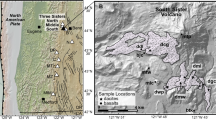Abstract
Experiments were conducted at 1 GPa on four starting materials to investigate the effects of variable mineral proportions on the melting systematics of compositionally fertile peridotitic assemblages. Starting materials were constructed by recombining Kilbourne Hole xenolith mineral separates by weight into four mixtures with mineral proportions olivine (Ol): orthopyroxene (Opx): clinopyroxene (Cpx): spinel (Sp) of 0.50:0.07:0.40:0.03 (FER-B), 0.50:0.46:0.01:0.03 (FER-C), 0.50:0.30:0.10:0.10 (FER-D), and 0.50:0.235:0.235: 0.03 (FER-E). Experiments were performed on a 1.27-cm (0.5 in.) piston-cylinder apparatus over the temperature interval 1270–1390 °C, using a variation of the diamond aggregate melt extraction technique employing vitreous carbon spheres in place of diamonds as the melt extraction layer. The solidus temperatures are similar for all the starting materials, with an average value of 1250 °C. In FER-D and -E, the near-solidus melting reaction for a lherzolite assemblage was determined to be of the form Cpx + Opx + Sp → melt + Ol. A subsequent reaction of the form Opx + Sp → melt + Ol was determined for FER-D after the exhaustion of Cpx. Over the entire temperature interval investigated for FER-B and -C, reactions were determined to be of the form Cpx + Sp → melt + Ol and Opx + Sp → melt + Ol, respectively. Melt percent (F) vs temperature (T) curves are concave up for all starting materials, demonstrating that isobaric melt productivity increases with progressive batch melting. At any given melt fraction, (dF/dT)P increases with increasing amount of Cpx in the starting material, indicating that the modal proportion of Cpx is one of the primary controls on isobaric melt productivity of upwelling peridotite. The concave up melt productivity functions for peridotitic assemblages determined in this study suggest that assuming linear or concave down melt productivity functions for modeling mantle melting may not be appropriate.
Similar content being viewed by others
Author information
Authors and Affiliations
Additional information
Received: 2 August 1999 / Accepted: 7 June 2000
Rights and permissions
About this article
Cite this article
Pickering-Witter, J., Johnston, A. The effects of variable bulk composition on the melting systematics of fertile peridotitic assemblages. Contrib Mineral Petrol 140, 190–211 (2000). https://doi.org/10.1007/s004100000183
Issue Date:
DOI: https://doi.org/10.1007/s004100000183




